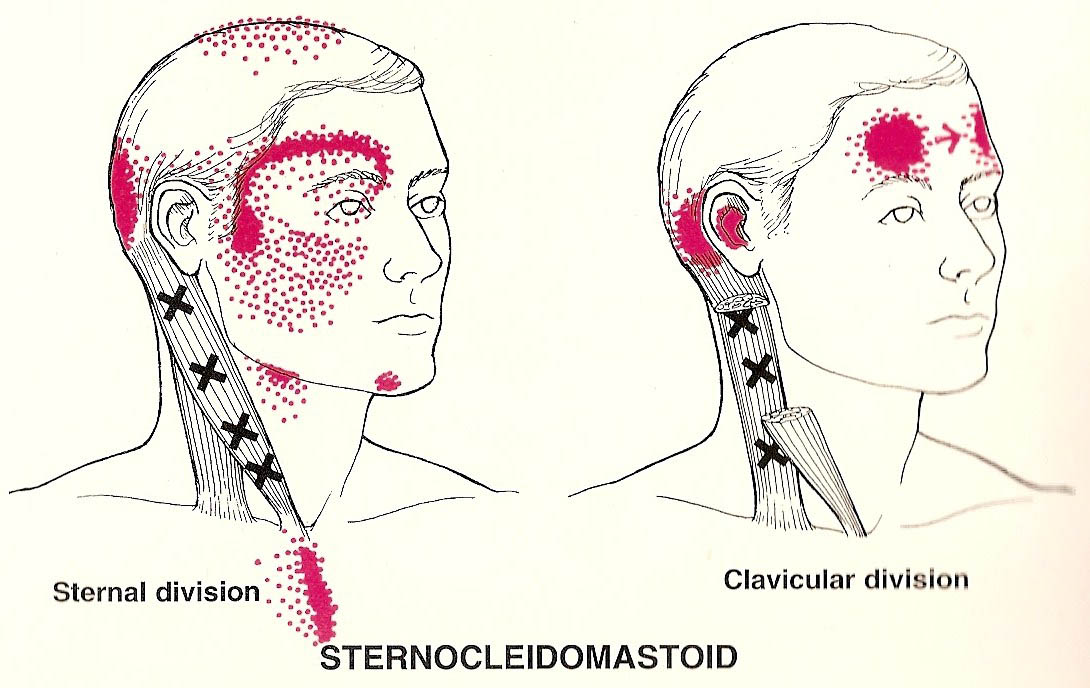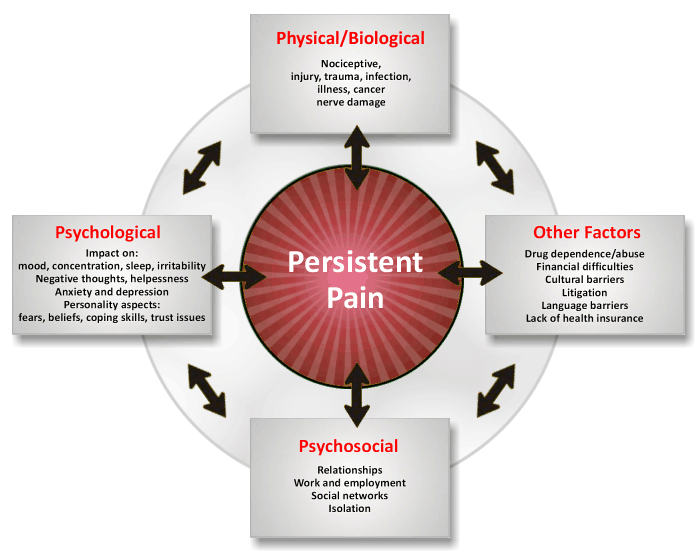|
Where is the pain?
Pain is felt in the body, by the brain. Acute pain is a sensory signal coming from the damaged or stimulated area of the body. The signal travels through the spinal cord and to the brain which interprets how much pain you should be, and consequently will be, feeling. So, your brain makes an educated guess which is based on all the relative information, including prior experience, visual input and emotional factors as well as actual tissue damage. In basic terms, the level of pain perceived is largely based on the level of threat perceived. We have all experienced a situation where we have not been in pain until we visually see that we have damaged ourselves. This reminds me of one time that I was cycling home on a dark winter night when my front wheel slipped on ice causing me to face-plant into the gravelly pavement and skid for a few feet. I was certainly aware of how uncomfortable this experience had been but it wasn't until I got home and looked in the mirror to see my swollen lip and grazed face that I realised how much pain I ought to be in. Here we have a pain stimulus that once backed up by info from our visual cortex is perceived to be a high enough level of threat to warrant a sudden upwards surge in pain level. This is all the more important to hold in mind in an era where just about anybody can search their symptoms up on google and catastrophise about a hundred and one horror stories related to “a sore back”. Owch!! If I have bulging discs will I be in pain? Well… maybe, but maybe not. More than 50% of people with MRI-detected abnormalities (such as bulging discs and disc protrusion) in their lumbar spine report no pain (Jensen et al 1994). There is a heap of studies that demonstrate this MRI scan phenomenon. In fact, many people who develop acute back muscle spasm and are diagnosed primarily on the basis of MRI scan findings may have unnecessary surgery that doesn't alleviate their symptoms. In another study Dr James Andrews performed MRI scans of 31 healthy pain-free baseball players shoulders and found that 90 percent of them had abnormal cartilage and 87 percent had abnormal rotator cuff tendons. One theory as to how this may happen is that if the joint degeneration develops over a long period of time then the brain will fail to register it as enough of a threat to the system to perceive it as pain. An acute knee cartilage tear on the football pitch would be much more likely to flag up as pain. Interestingly, you can determine the presence of chronic pain pathology by changes found within regions of the brain… For example, if a limb is in chronic pain then it will show marking within that specific region of the somato-sensory cortex. “The most consistent biomarker for chronic pain involves changes in the function and structure of cortical areas of the brain – whatever the diagnoses” (Apkarian et al 2009). What is the difference between acute and chronic pain? Well… No! As we worked out earlier, pain is extremely subjective. There are many different types of sensory nerve receptors and fibres attuned to different stimuli. We can make a significant distinction by considering the differences in the biological processes of acute and chronic pain: Acute Pain The first 48 hours after an injury is considered the acute phase. This acute pain is the sort of pain that results from an acute stimulus such as a pin-prick or tissue damage from an injury like a sudden twist of the neck as you turn to face your beloved but bothersome offspring throw their dinner on the floor. Following an incident such as this there will be an inflammatory reaction which will cause a relatively sharp pain that carries along larger and faster nerves called type A myelinated nerve fibres. Sometimes however, after a tissue-healing period or even just after any of the multitude of pain contributing factors start getting loud enough for you to perceive them, you will experience chronic pain. Chronic Pain Chronic Pain is pain that has been around for some time. A number of physiological changes will have been made by the nervous system during the period taken in order for it to become a chronic pain. Chronic pain is usually travelling down slower, smaller nerves called type C fibres. These nerve fibres give a more dull, achey or throbbing sensation. Whereas most sensory nerve receptors will stop being registered by the brain after a period of time, (including type A nerve fibres), type C fibres can be constantly firing. Superficial sensory nerve receptors in our skin allow us to feel the sensation of fabric on our skin when we put our clothes on in the morning, but we don't carry on feeling them all day long. The constant type-C pain signals, however, become a persistent irritant to our autonomic nervous system. This, over time may push our body into a more sympathetic nervous system dominant, fight or flight state. Sensitisation in chronic pain What is interesting about chronic pain is that the connection between the level of tissue damage sustained and the pain perceived may have moved even further away from each other. This is basically due to the neural activity (in this case pain) being activated so much that the brain becomes more and more sensitive to it. We can see this type of neural priming with all sorts of everyday activities, from roller skating to long division, we gradually learn to become more specialised to deal with what we are most exposed to, which in this instance, is pain. So this process is called long term potentiation, and is present to some extent in all long-term chronic pain problems. "It now seems as if pain carves a path through us in the same way that water creates a route down the side of a mountain. It flows where it must. Chronic pain is the result of flooding on that pathway until it erodes a deeper channel, or creates new ones... The longer and deeper pain flows the more it lays down a sensitised trail for future pain" Jackson 2002 (taken from Cranial intelligence by Ged summers and Steve Haines). Central Sensitisation In some cases chronic pain sensitisation can lead to a hypersensitivity to multiple sorts of stimulus. This is called central sensitisation. This involves an increased sensitivity to mechanical pressure, temperature, bright lights, noise or even medication. This pattern is often associated with other triggers such as emotional distress, lack of sleep, excess medication, tissue-irritating dental fillings, unsuitable diets or irregular eating patterns. One must not forget that being in chronic pain leads us to a chronically over-active sympathetic nervous system leading to a sustained arousal of fight or flight body state. This state sharpens our senses, causes our eyes to dilate, increases muscle tone, prevents proper restful sleep, decreases our ability to digest food properly, and speeds up our breathing and heartbeat amongst many more physically and mentally distressing symptoms. Being in chronic pain is downright exhausting, we should appreciate the self perpetuating nature of pain if we want to have a better grip on managing it. Pain ►Fight or flight nervous system state ► Less restful sleep + emotional stress + increased muscle tension ► increased sensitivity to pain and stress ► more and more pain.... Phantom limb and internal body maps An interesting phenomenon that demonstrates how pain isn't always related to tissue damage is called "phantom limb syndrome". This is where someone who has lost a limb, or other body part, through amputation or an accident still registers sensation where that limb used to be. This sensation is in 70% of cases sensed as pain, however, it can also be a contraction or altered spatial perception. This rather distressing syndrome tells us so much about how the brain works. It really highlights the distortion between our cognitive perception of the body and our sub-conscious neural perception of the body. We all have a sub-conscious body map. Just as in the case of a phantom limb patient physically feeling a body part that isn't there, in many chronic pain cases we may be sensing a pain that has already healed. Much of my bodywork is about bridging this gap between objective tissue changes and perceived neural input. It's like a kind of re-tuning of our somatic nervous system. The hierarchical sensory world This "body map" is an amalgamation of all the neural input. So if we look at all the internal neural input we can see that there are many different contributions from different types of nerve receptors. We can broadly categorise them into terms of nociceptive, which are associated with pain, proprioceptive which is kinaesthetic or sense of bodily orientation, interoceptive or internal perception such as that of the viscera, chemoceptive i.e. temperature perception. We also know that pain works in a somewhat hierarchical fashion. All of these different types of sensation are all signals and they compete for recognition into our conscious neural feed. When we fall and hit our knee we instinctually hold and rub it. The sensation of holding and rubbing, which feeds into our mechanoceptors and somewhat reduces the nociceptive pain signals from reaching their target. It is a bit like who shouts the loudest and for the longest duration will get the most attention from the brain. As we know from before type C chronic pain nerve fibres can consistently be firing. This means that after a period of time people in chronic pain don't just become better at feeling pain but they now lose a significant portion of other types of sensory input. Pain begins to rule the show! Emotional Pain If we want to understand pain, we have to account for the emotional contributions. We may learn to associate physical feelings with emotional pain. To borrow the second part of the quote I started earlier, "The longer and deeper pain flows the more it lays down a sensitised trail for future pain. And this can become a conduit for other kinds of pain - divorce angst will head straight for that channel, until body pain and life pain become indistinguishable... Pain creates a language for wordless events like loss. Sometimes I think pain is just the body thinking out loud" (Jackson 2002). To complicate the matter further we may associate negative past emotional experience with physically felt sensation that re-emerges as a kind of emotional somatic memory from the time of the initial trauma. A feeling of grief that surfaces as we sink with our listening elbows into a sore shoulder that started at the time we lost a loved one or even the gutting feeling of past rejection that re-emerges when we release the diaphragm with a myofascial release technique. Sensory signals offer us a narrative to our emotional existence, a way of associating the experience of the things around us with the feelings within. Even on a sub-conscious level we are responding and acting upon internal feelings all the time. Our gut feelings or butterflies in our stomach are examples of language that we use to explain the physical sensations that can alter and shape our behaviour. Some practical tips on how to better regulate pain. A person in chronic pain is like a loaded donkey. The more loads the donkey has to carry the closer it will get to collapsing. Equally, the more factors we have contributing to the pain, the harder it will be to overcome. The best way to start is to take off some weight. It may be wise however, not to do it too quickly. It will not help you to be seeing five different types of therapists simultaneously whilst fasting on a smoothie diet and seeing a personal trainer. Each load you take off will be a change that your system will have to deal with. Make considered interventions individually so you can see how your body is responding. . Awareness is half the battle. Educate yourself in pain science and use it to manage your pain instead of fighting it. . Don't catastrophise. Internal neural input is modified by structures such as our frontal lobe, the visual and auditory cortex. Reading scary internet blogs about illness can be a slippery slope. . Calm down the nervous system. An overactive sympathetic nervous system makes it very difficult to make any progress. Bodywork such as taichi and yoga that train breathing and body awareness are excellent ways of reducing sympathetic overdrive, amongst many other benefits. . Overcoming pain isn't just about eradicating the bad signals as if it is an enemy. Introduce other signals that can add to your available menu of sensory input. Acupuncture, yoga, massage are potentially all sophisticated ways of talking to the nervous system and introducing more harmonious connections with the bodies we inhabit. . Exercise . Don't come to the clinic after skipping breakfast and having two double shot cappucinos and wonder why it is more painful than last time. . Do nice things and take good rest. Nourish yourself
1 Comment
|
Oscar
Some musing for The Mews ArchiveCategories |
HoursPlease call or email your practitioner to arrange an appointment.
|
Email & Telephone (Please click on the links) |
Social Media |

 RSS Feed
RSS Feed



